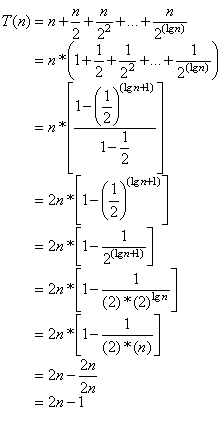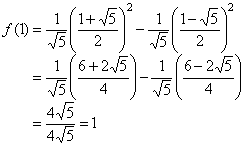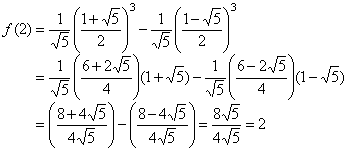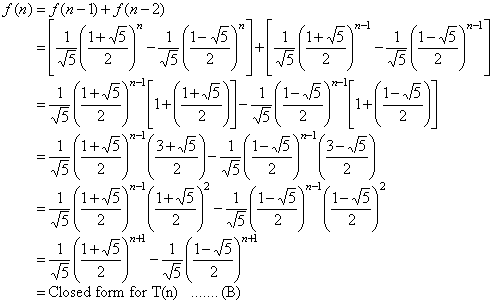For the following algorithm segment, give T(n), the exact number of times the line x := x + 1 is executed. Assume n is any positive integer which is a power of 2.
j := n
while j >= 1 do
begin
for i := 1 to j do
x := x + 1
j := j / 2
end
ANSWER:

So, the closed form is T(n) = 2n - 1, for all n >= 1.
Suppose f(x) = O(xm) and g(x) = O(xn), where m, n are positive integers. Then f(x)*g(x) = O(xm+n).
ANSWER:
Proof: By defnition of big-Oh notation and the given assumptions on f and g, we know there exist c1, c2, x1, x2 such that
f(x) <= c1 * xm (for all x >= x1) and g(x) <= c2 * xn (for all x >= x2).
Since m, n are positive integers, we get
f(x) * g(x) < = c1 * c2 * x(m+n), for all x >= max(x1, x2).
So, we can take c = c1 * c2, and n0 = max(x1, x2).

- Verify that this formula produces the same values as
the recurrence relation for n = 1 and 2.
ANSWER:
- For n = 1:
- Recurrence: f(1) = 1 ... by definition of fibonacci sequence
- Closed form:

So, frecurrence (1) = fclosed (1).
- For n = 2:
- Recurrence: f(2) = 2 ... by definition of fibonacci sequence
- Closed form:

So, frecurrence (2) = fclosed (2).
- For n = 1:
- Prove by strong mathematical induction that this formula is correct.
ANSWER:
Theorem: Fibonacci sequence defined recursively as
f(n) = f(n-1) + f(n-2), f(1) = 1, f(2) = 2
has an equivalent closed form

Proof: by strong mathematical induction.
Basic Step (n = 1, 2): As shown in part a. ... (A)
Inductive Step: Assume the closed form holds for all f(i), 1 <= i < n. Show the closed form holds for f(n).

From (A) and (B), the theorem is true.
Input: The sequence s1, s2, .., sn and the
length n of the sequence.
Output: The minimum value in the sequence.
procedure find_min(s, n) 1. if n = 1 then 2. return s1 3. else 4. begin 5. x := find_min(s, n-1) 6. if x < sn then 7. return x 8. else 9. return sn end find_min
Let T(n) be the number of times the comparison x < sn (line 6) is performed in the worst case.
- Find a recurrence relation and an initial condition for T(n).
ANSWER: T(n) = T(n-1) + 1, T(1) = 0
- Solve the recurrence relation you answered in a. and derive a closed
form.
ANSWER: I skip the derivation here, assuming you know how to do this very well already. The closed form is
T(n) = n - 1, for all n >= 1